After two and a bit hours I arrived at Bristol Parkway station on the outskirts of town, and took a bus into the centre, along with a crowd of gabbling and hoicking local youths gearing up for a massive night on the town. Their wardrobe of choice for the evening's revels was the timeless askew baseball cap underneath a hoodie combo, with extra added cheap bling jewellery.
After half an hour the bus arrived in the concrete centre of Bristol and I made my way the short distance to the YHA right on the dockside. Bristol has been sprucing up its waterfront area for years now, and these days it's loaded with bars and cafes alongside the launches and yachts. The YHA is located in a tall narrow brown-brick building in which I’d stayed briefly in the distant days of 1997. My only two memories of the place were a dormitory chat with a young chap who turned out to be a filmmaker and a Young Conservative (I got him interested in Merata Mita’s film Patu about the 1981 Springbok tour), and the night-long rowdy noise from a boisterous queue outside a nightclub behind the hostel. Luckily the dormitories are on the other side of the building now! And as is the way of things, the first person I met in the dormitory was a chap from Karori. We get about, you know.
===
After an early breakfast in the hostel café I took the 9.19am train from nearby Bristol Temple Meads southwest to Exeter St David’s station. As opposed to Exeter Central or Exeter St Thomas; quite why a rather small city like Exeter needs three railway stations is beyond me. Anyway, after the hour-long journey through Somerset and Devon, I walked through the Exeter streets thronged with Saturday morning shoppers, and made my way to the centre.
The main purpose of my visit was to enjoy the morning tour of the beautiful Exeter Cathedral. Like most English cathedrals, it has evolved over the course of several centuries: this plan outlines the stages, from the 12th century Norman transept towers, the 13th century Chapter House, to the 13th and 14th century quire and nave. The cathedral boasts the longest uninterrupted vaulted nave in England – others have longer naves but they’re broken by central towers, like that at Ely – and a huge Ptolemaic clock in the north transept that’s over 500 years old.

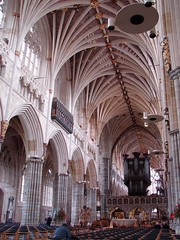
The longest unbroken nave in England
Originally uploaded by eT le snap

After admiring the huge 14th century wooden canopy for the bishop’s throne, the cathedral guide told us about an odd Bishop after whom the wooden statue of St Peter was modelled. The Right Reverend Lord (Rupert Ernest) William Gascoyne-Cecil was Bishop of Exeter from 1916 to 1936, and was quite the English eccentric. He was popular with his parishioners despite frequent bouts of odd behaviour. It was the days when most bicycles looked fairly identical, and he was so forgetful that he always took the first bicycle he saw, taking it to be his own. (People didn’t worry about locking their bikes up back then). The townsfolk of Exeter worked their way around the problem by finding the bishop’s own bicycle and painting it bright yellow so it’d be easier to remember which one was his. His forgetfulness also led him to forget what he was doing at times. On one occasion he arrived by train at Ilfracombe on the north Devon coast, and immediately sent a telegram to his wife, Lady Florence, in Exeter:
HAVE ARRIVED ILFRACOMBE. WHY?
Now Bishop William is fondly remembered in a plaque near the bishop’s canopy, and by the slightly forgetful air of the carving of St Peter, which looks down from the crest of the canopy with an air of bemused distraction.
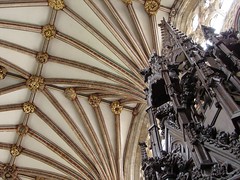
Bishop's throne canopy
Originally uploaded by eT le snap
Elsewhere in the cathedral I particularly enjoyed the wood panel paintings in the eastern chapels, including the one of St Apollonia, the patron saint of dentistry, holding a wicked set of pliers with a molar clamped in their iron jaws.

Flanking the Lady Chapel at the far eastern end of the cathedral are two tombs of medieval Bishops of Exeter. One, Bishop Walter, who held the post from 1257 to 1280, still boasts its original 15th century paintwork. The other, of Bishop Edmund (1395 to 1419) has been scored all over its length with a myriad of pilgrims’ initials as a mark of their journeys to Exeter. In some places they have inscribed the date of their visit along with their initials, such as the intricately carved initials of ‘A.T.’, who visited in 1601 (the year in which the former favourite of Queen Elizabeth, Robert Devereux, the Earl of Essex, was beheaded for treason), or that of ‘M.Z.’, who passed through in 1616 (the year that Indian princess Pocahontas arrived in London with her English husband, James Rolfe). The inscriptions even cover the face of the bishop’s carving. One can’t help but wonder how people got away with this kind of vandalism – perhaps at evening services when the light was much dimmer?

Soon it was time for lunch, so I purchased a superb pasty from a local bakery, to enjoy whilst sitting in the sunshine in the cathedral grounds. Everyone else had the same idea, but the grounds are spacious and there was plenty of room for hundreds of people to sit and pass the time.
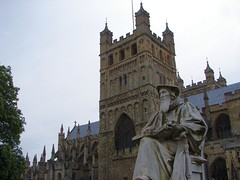
Exeter Cathedral
Originally uploaded by eT le snap
After a little more wandering around the town, and discovering that the town's museum was closed for refurbishment, I decided to take the train halfway back to Bristol to the town of Taunton. It’s the county town of Somerset, and despite the blue skies and sunshine filling the streets with merry locals doing their weekend shopping, there wasn’t that much to see. I did enjoy the sight of this fellow waiting patiently outside a fish and chip shop for his owners to emerge.
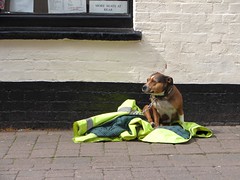
Just waitin' for my man
Originally uploaded by eT le snap
After an hour or two surveying the high street shops, and having ascertained that the county cricket ground wasn’t hosting a match that afternoon, I made my way back to the station for the next train back to Bristol. (At the station I noticed this advert – I wonder if you’d see something like that in New Zealand?)
Back in Bristol I walked around the town for ages looking for something suitable for dinner, but in the end I had no other choice than to opt for a particularly greasy cod and chips. Afterwards I returned to the hostel and listened to the dilettante Russell Brand’s Radio 2 show on my mobile phone’s headset.
===
The next morning I left the hostel after breakfast at 9 o’clock to explore harbour-side Bristol. By 10am I was in position to be the first visitor of the day at one of Bristol’s prime tourist attractions: the dry-docked SS Great Britain. When it was launched here in Bristol in 1843 from the same dry-dock in which it now resides, it was the world’s largest ship. It was also arguably the first modern ocean-liner, in that it was primarily driven by steam engine rather than by sail, and it had a screw propeller at the stern rather than paddle boxes at each side. On 11 August 1845, the day it first arrived in New York, the local newspaper the Evening Post wrote:
This magnificent steamship, so long expected at this port, has at length arrived. Thousands rushed to the Battery, and every other spot which would afford a favourable view of her… wonder and astonishment was loudly expressed as they saw and comprehended her vast proportions and beautiful sailing qualities.
After many years as an Atlantic liner and then as a colonial transport ferrying settlers to Australia, the Great Britain ended up forgotten at the bottom of the world, anchored in a bleak cove in the Falkland Islands. It was brought back to Bristol by a tug in 1970 and opened for public viewing in 2005.
The dry-dock in which it rests has been sealed with a glass ceiling halfway up the hull of the vessel, to minimise rusting of the lower hull. A thin layer of water atop this glass artificial ‘sea’ provides the illusion that the ship is afloat, and enables visitors to clamber underneath the hull and examine the propeller, keel and bow.
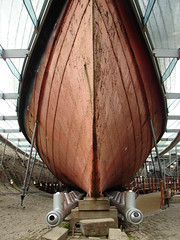
SS Great Britain
Originally uploaded by eT le snap
Inside the ship it was interesting to see the tiny first and second class cabins, and to compare them to the even more cramped steerage quarters, in which the poorest passengers had little space, privacy or natural light. In its days as a settler ship the passengers would spend 60 days afloat en route from Liverpool to Melbourne. The lucky passengers with first or second class tickets could mingle in the lush and spacious saloon and the grand dining room, but for the steerage passengers it must have been a lengthy ordeal.

Steerage
Originally uploaded by eT le snap
Next to the Great Britain there’s also a replica of the Matthew, the Bristol ship that took the explorer John Cabot (who was actually a Genovese, Giovanni Caboto) across the Atlantic to discover Newfoundland in 1497, five years after Christopher Columbus’ voyage to the Caribbean. The replica had arrived in Bristol with great fanfare back in 1998 when I was travelling in the West Country with my mother and aunt. But while I could get a good look at the little ship from the dockside, it appeared my luck had not improved from the day before, because the Matthew was closed for refurbishment during my visit.

After exploring the Great Britain I made my way to the station again for a 10 minute journey eastwards to nearby Bath, one of the most beautiful towns in England. I had enjoyed visits here in 1997 and 1998, but the lure of its superb World Heritage Site architecture and the sights of the town had drawn me back. Set on an imposing hillside that sweeps down to the site of the Roman Baths and Bath Abbey, much of the city is built from creamy local stone, which gives the town a style of its own that has ensured it has remained a popular tourist destination for centuries.
First I walked up the hill to admire again the beautiful houses of the Circus (built 1754-68) and the Royal Crescent (built 1767-74), both sweeping ranks of stylish townhouses built to shelter the wealthy elites of England when they visited to take the waters and be seen in society. The video of the Circus is taken from the grove of trees at the centre, while the picture is from the circumference. One day I'll go back to Bath with a wide-angle lens so I can get a good shot of the Crescent!
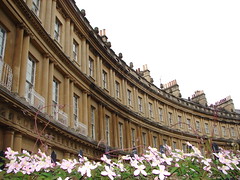
The Circus, Bath
Originally uploaded by eT le snap
A third 18th century edifice is the just-so arches and shops of the Pulteney Bridge across the Avon, with its ornamental waterfalls guarded by smartly turned-out armies of river ducks.


Do you like my profile?
Originally uploaded by eT le snap
I spent half an hour visiting Bath Abbey, a large Gothic church in the middle of town, best known for its splendid front upon which great ornamental ladders reach up to Heaven, with platoons of winged angels climbing up to salvation. It is said that the idea for the design came from an Abbot’s dream.

Afterwards there was time to wander past the Bath Cricket Club, where a black and white cat was calmly watching a girls’ match from the vantage of the boundary wall, and take in the lovely books at an independent booksellers, where I noticed this striking display of Ordnance Survey maps.
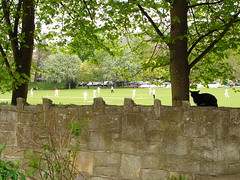
The summer game
Originally uploaded by eT le snap

Ordnance Survey
Originally uploaded by eT le snap
Then it was time to return to Bristol. At Temple Meads station I passed TV stylist Gok Wan hurrying to make his train back to London, and then I found the dockside area heaving with hundreds of locals, in town to watch some big football match on TV. I took a detour around the various arms of the riverside docks, and spotted this furry security guard on the prow of a dilapidated barge - on the lookout for fish thieves?

Pirate kitty
Originally uploaded by eT le snap
Noticing the number of police around the football revellers – I saw 12 PCs within a 100 metres – I decided to stay out of the way in the hostel with my earplugs in!
===
The earplugs worked well and it seems the night passed without a major hitch, because there were no chalk outlines of revellers’ corpses on the dockside when I emerged in the morning. There was time to amble through Bristol’s town centre in the morning, admiring the fortitude of the thousands of townsfolk who had turned out for a 10 kilometre fun run through the closed-down streets. I took in the views of Bristol Cathedral and the steep hillside park crowned with the 19th century Cabot memorial tower.


Then soon enough it was time to head back to collect my bag, and make my way to Temple Meads again for my train back to Paddington. It had certainly been a good bank holiday weekend away in the West Country.
No comments:
Post a Comment